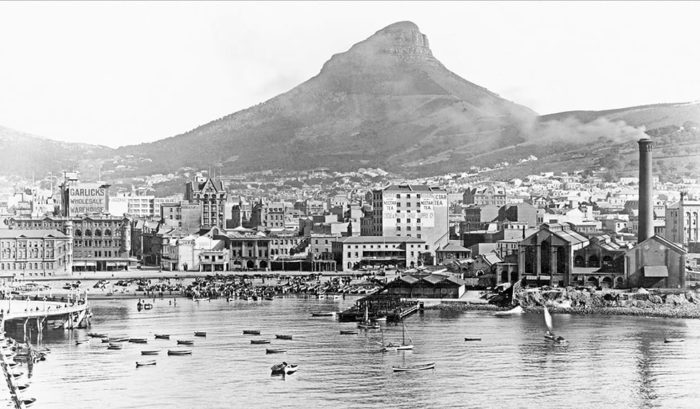Over the years, Cape Town’s watchful guardian Lion’s Head has looked over the city from it’s mountainous perch, like Mufasa watched his lands from pride rock. As our beautiful home has changed with each passing decade, one of our ‘mane’ mountains has stayed a constant, offering comfort to those looking out over the skyline.
Join us in looking back over the years come and gone while Lion’s Head patiently watched over us all.
Originally known as Leeuwen Kop by the Dutch, Lion’s Head as we know it today has been part of Cape Town’s backdrop since before the Mother City was even established.
English settlers in the 17th century used to call the mountainous peak Sugar Loaf.

In roughly 1897, the Queen’s Hotel was an established landmark in the Seaport area. It had a luxurious Victorian theme and opulent interior decor to match.
Lion’s Head watched over this iconic building for years until it was demolished in 1936.

Salt River was just a small village that overlooked a river and was nothing but a few Fisherman’s Cottages in 1665. Lion’s Head watched over the area and saw the bountiful river come and go, as the city lifestyle took over the area from when the Railway Line from Cape Town was established in 1862.

Lion’s Head and it’s surrounds is one of Cape Town’s most historically rich locations. Although the mountain does indeed look like a lion relaxed in a Sphinx pose, this is not where the name originates from.
The slopes now frequented by tourists and Capetonians alike used to be home to black-maned Cape lions. These fearsome creatures used to cause havoc for farmers in the area and even killed a soldier or two in their time.

Over the years, this famed mountain inspired many folklores and stories told to both young and old.
In 1886 a man claimed to have discovered gold on Lion’s Head. A shaft was sunk beneath the mountain in search of riches in the same year. A Lion’s Head Syndicate was established to carry out the search. However, in 1888 the venture failed due to lack of support and our beautiful mountain remained unscathed.

Lion’s Head also watched the old Cape Town Pier come and go. The harbour pier was built at the bottom of Heerengracht in 1910 and featured a pavilion where ballets and concerts were frequently hosted.
In 1939 the boundaries of the foreshore were pushed further out and the area was claimed for building, so the pier was demolished to make way for streets and buildings.

Now a busty and bustling street in the heart of the Cape Town CBD, Strand Street used to be located at the boarder of the beach. This area was established as a base for Dutch settlers and disappeared with time as the shoreline was reclaimed in later years.

Before the Foreshore was reclaimed, Lion’s Head was peering over the buildings and watching over the boats as they reached the harbour.
Buildings popped up all over the area after the land was reclaimed from Table Bay in the 1930s and 1940s in connection with the construction of the Duncan Dock to replace the old harbour.
No matter how many years pass by, Lion’s Head will always have a special place in our hearts and continue to watch over us and see the city change but hopefully not too much.

Since 1926 one of Cape Town’s most-loved attractions, The Table Mountain Cableway, has taken more than 28-million people to the summit of Table Mountain.
For more than 92 years, Lion’s Head has watched guests visit the iconic landmark and seen the cableway develop.

This article was complied with the help of local group Cape Town Down Memory Lane, if you like these pictures join the group for more.
Pictures: Cape Town Down Memory Lane

